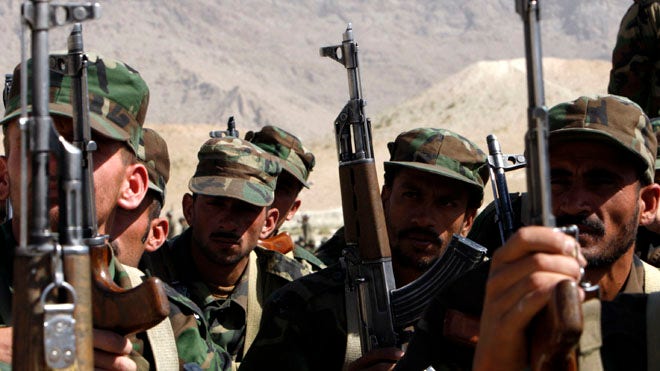Results 1 to 1 of 1
Thread Information
Users Browsing this Thread
There are currently 1 users browsing this thread. (0 members and 1 guests)
-
09-21-2013, 07:25 PM #1
Afghan troop deaths hit record 100 per week amid US exit
Afghan troop deaths hit record amid US exit
Published September 21, 2013The Wall Street Journal

FILE 2008: Afghan National Army soldiers attend a class in Kabul. Recently, these troops appear less able to fight and save the lives of their critically wounded. (Reuters)
Afghan troops are in the midst of their deadliest fighting season since the war here began 12 years ago.
That is because, as U.S.-led forces withdraw, the Afghans are fighting a different war.
The Taliban are growing more aggressive. Coalition forces, taking with them their superior training and equipment, are leaving Afghan troops less able to fight and less able to save the lives of their critically wounded.
The Afghan forces—including the army, national police and village self-defense police—have been losing well over 100 men a week to insurgent attacks, with close to 300 injured, through much of the summer, according to numbers provided by coalition officials.
By contrast, coalition fatalities, which are reported precisely, have fluctuated between 13 and 27 troops a month since heavier fighting resumed in the spring.
To put it in perspective: The Afghan forces' death toll is as much as three times the combined coalition and Afghan fatalities in 2010 and 2011, when the U.S. took its heaviest casualties in the war.
Casualty levels "approach rates that we took in Vietnam"- U.S. Army Lt. Gen. Mark Milley, the commander of the International Security Assistance Force Joint Command
U.S. Army Lt. Gen. Mark Milley, the commander of the International Security Assistance Force Joint Command, said Afghan casualty levels "approach rates that we took in Vietnam."
Kabul no longer releases total Afghan casualty statistics in order, officials say, to safeguard morale. But Afghan officials said casualty levels for the police and army have climbed since last year, making 2013 the bloodiest for Afghan forces since the U.S.-led coalition arrived in 2001.
Afghan President Hamid Karzai addressed the level of bloodshed in public comments on Tuesday. "I read the daily security reports each afternoon that say four or five civilians, around 14 or 15 Afghan security forces and more than 35 or 45 Taliban have been killed," he said. "All are sad and all of them are Afghans."
Added Mr. Karzai: "How long does this situation have to go on?"
As coalition forces pull back from combat ahead of next year's withdrawal, some coalition commanders warned that the Afghan forces can't be sustained over the long run at the current rate of attrition.
The Afghan army, for instance, is losing 34.8% of its manpower a year as soldiers desert, are killed in battle, and are discharged because of injury or released because they completed their service, according to figures provided to The Wall Street Journal by the U.S.-led coalition.
Coalition officials said the Afghans have been recruiting enough soldiers and police to make up for the high level of attrition.
But for reasons beyond troop numbers, the trends may be unsustainable. "In the general attrition rates, you are losing skilled fighters," said Anthony Cordesman of the Center for Strategic and International Studies in Washington.
The high casualty rates don't mean that the Afghan army and police are about to collapse, said Gen. Milley.
"The ability to take casualties is directly related to the political object to be achieved," Gen. Milley said. "And for the Afghans…they are fighting for their country. They're fighting for the very existence of their future."
http://www.foxnews.com/world/2013/09...#ixzz2fZYZJTo2NO AMNESTY
Don't reward the criminal actions of millions of illegal aliens by giving them citizenship.
Sign in and post comments here.
Please support our fight against illegal immigration by joining ALIPAC's email alerts here https://eepurl.com/cktGTn


 LinkBack URL
LinkBack URL About LinkBacks
About LinkBacks




 Reply With Quote
Reply With Quote


"YOU WILL FOOT THE BILL FOR ILLEGAL IMMIGRANTS!" GOVERNOR HOCHUL...
04-23-2024, 05:46 AM in Videos about Illegal Immigration, refugee programs, globalism, & socialism